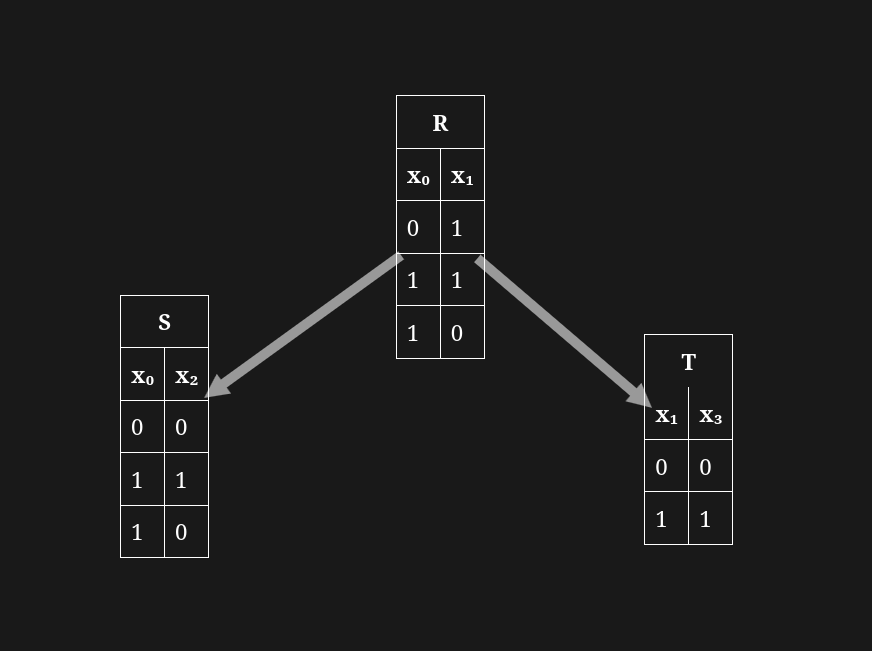From Queries to Circuits
Florent Capelli
Université d’Artois - CRIL
Dagtsuhl Seminar
Representation,
Provenance, and Explanations in Database Theory and Logic
January 17, 2024
Representing Relations
Relations from Queries and Databases
- query with free variables
- database on domain
define the relation of answers of over
is an implicit representation of a relation of .
Relations from Tables
A relation can also be explicitly represented as a table:
| 1 | 2 | 1 | 2 | 0 | 1 |
| 0 | 0 | 1 |
| 1 | 2 | 0 |
Problems defined on Relations
Given a representation of :
- Emptiness: decide whether
- Totality: decide whether
- Size: output
- Sample: sample uniformly
- Enumeration: output every tuple in .
- Direct Access: given , output the tuple of (assuming an order on ).
- Aggregation: output for some
Representation and Complexity
Complexity varies depending on the representation of .
| Problem | (CQ,) | Table |
|---|---|---|
| Emptiness | -hard | |
| Totality | ||
| Size | -hard |
A table is less succinct than a query but more tractable.
Looking for tradeoffs!
A Factorized Approach
s
- a finite set of variables.
- a finite domain.
Smoothness
Interpret * either by as “any domain value” or “a
default domain value” (zero suppressed semantics).
-circuit
Syntactic unambiguity
Decision Gates:
Comparing circuits
| Gates | Boolean Domain |
|---|---|
| NNF | |
| DNNF | d-DNNF |
| dec-DNNF | |
| FBDD |
Tractability Map
a circuit on domain and variable with .
| Gates | Emptiness | Totality | Size | Enumeration |
|---|---|---|---|---|
| NP-complete | coNP-complete | #P-complete | NP-hard | |
| coNP-complete | #P-complete | -delay | ||
| -delay | ||||
|
-preproc
-delay |
Assuming manipulating integers of size is polynomial in .
Complexity that only depends on is constant time in the data complexity model!
Compilation
Framework
Given a full conjunctive query and a database , construct a representing .
- Construction cannot be polynomial in and in the worst case (see lower bounds for DNNF).
- There exists tractable family of CQs:
- Acyclic conjunctive queries have of size .
- Conjunctive queries have of size .
Acyclic Conjunctive Query
A CQ is acyclic iff it has a join tree.
Yannakakis and circuits
Trace of Yannakakis algorithm can be seen as a , see [Olteanu, Závodný].
A DPLL-like procedure
DPLL size guarantees
If is “compatible with a join tree”, produced circuit has size linear in .

Fixing :
- decision tree with at most leaves
- breaks into two connected components
- Caching: and yield the same recursive call on the left tree.
This is roughly the caching in Yannakakis seen from above.
Elimination order only, no join tree!
DPLL and Negated Atoms
DPLL Guarantees
For , let .
If is good for every then DPLL returns a circuit of size linear in (and poly in ).
In particular, is acyclic for every .
If induces a fractional hypertree decomposition of width at most for every then DPLL returns a circuit of size (and poly in ).
Application
For a circuit on variables and :
| Gates | Emptiness | Totality | Size | Enumeration |
|---|---|---|---|---|
|
-preproc
-delay |
||||
|
-preproc
-delay |
where contains negative atoms!
Bonus: circuit produced by DPLL have an extra structure allowing direct access for induced lexicographical order.
Circuit propaganda Conclusion
- Circuit are a useful abstraction.
- Hard-lifting is compilation, algorithms are usually elementary.
- Unify results, similar ideas popped into many communities.
- Downside: Structure of the query may be lost during the compilation.